2011 Hyundai Accent steering
[x] Cancel search: steeringPage 49 of 232
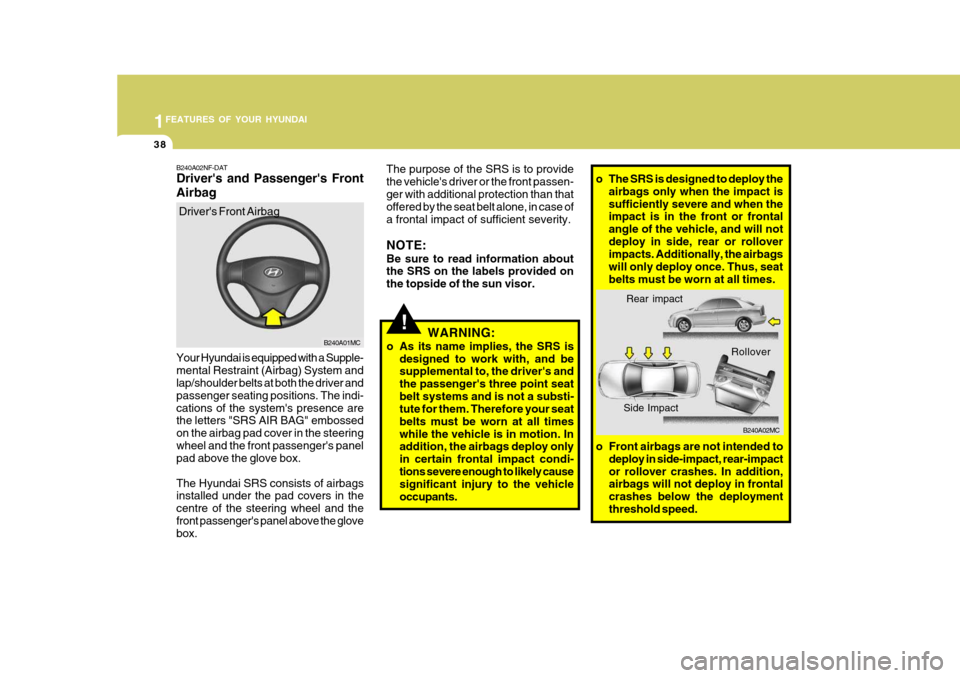
1FEATURES OF YOUR HYUNDAI
38
!
B240A01MC
o Front airbags are not intended todeploy in side-impact, rear-impact or rollover crashes. In addition, airbags will not deploy in frontal crashes below the deploymentthreshold speed.
o The SRS is designed to deploy the
airbags only when the impact issufficiently severe and when the impact is in the front or frontal angle of the vehicle, and will notdeploy in side, rear or rollover impacts. Additionally, the airbags will only deploy once. Thus, seatbelts must be worn at all times.
WARNING:
o As its name implies, the SRS is designed to work with, and be supplemental to, the driver's and the passenger's three point seatbelt systems and is not a substi- tute for them. Therefore your seat belts must be worn at all timeswhile the vehicle is in motion. In addition, the airbags deploy only in certain frontal impact condi-tions severe enough to likely cause significant injury to the vehicle occupants.
Your Hyundai is equipped with a Supple-mental Restraint (Airbag) System and lap/shoulder belts at both the driver and passenger seating positions. The indi-cations of the system's presence are the letters "SRS AIR BAG" embossed on the airbag pad cover in the steeringwheel and the front passenger's panel pad above the glove box. The Hyundai SRS consists of airbags installed under the pad covers in the centre of the steering wheel and thefront passenger's panel above the glove box.
B240A02NF-DAT Driver's and Passenger's Front Airbag
Driver's Front Airbag The purpose of the SRS is to provide the vehicle's driver or the front passen-ger with additional protection than that offered by the seat belt alone, in case of a frontal impact of sufficient severity. NOTE: Be sure to read information about the SRS on the labels provided on the topside of the sun visor.
B240A02MC
Rear impact
Side Impact Rollover
Page 50 of 232
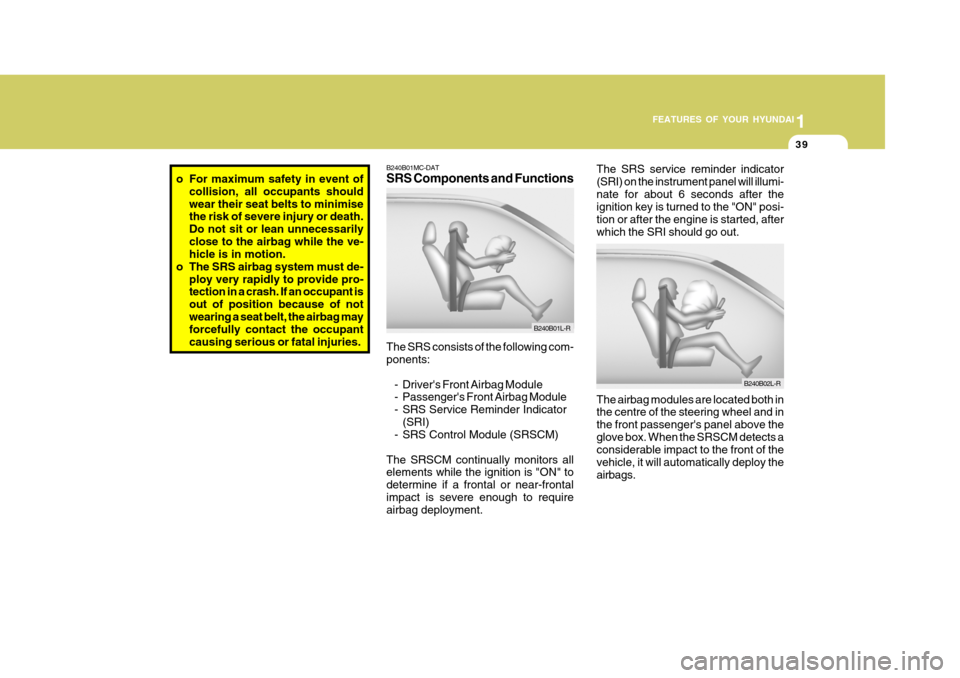
1
FEATURES OF YOUR HYUNDAI
39
o For maximum safety in event of
collision, all occupants should wear their seat belts to minimise the risk of severe injury or death. Do not sit or lean unnecessarilyclose to the airbag while the ve- hicle is in motion.
o The SRS airbag system must de- ploy very rapidly to provide pro-tection in a crash. If an occupant is out of position because of notwearing a seat belt, the airbag may forcefully contact the occupant causing serious or fatal injuries. The SRS consists of the following com- ponents:
- Driver's Front Airbag Module
- Passenger's Front Airbag Module
- SRS Service Reminder Indicator(SRI)
- SRS Control Module (SRSCM)
The SRSCM continually monitors all elements while the ignition is "ON" to determine if a frontal or near-frontalimpact is severe enough to require airbag deployment.
B240B01MC-DAT SRS Components and Functions
The SRS service reminder indicator (SRI) on the instrument panel will illumi-nate for about 6 seconds after the ignition key is turned to the "ON" posi- tion or after the engine is started, afterwhich the SRI should go out.
B240B01L-R
B240B02L-R
The airbag modules are located both in the centre of the steering wheel and in the front passenger's panel above theglove box. When the SRSCM detects a considerable impact to the front of the vehicle, it will automatically deploy theairbags.
Page 53 of 232
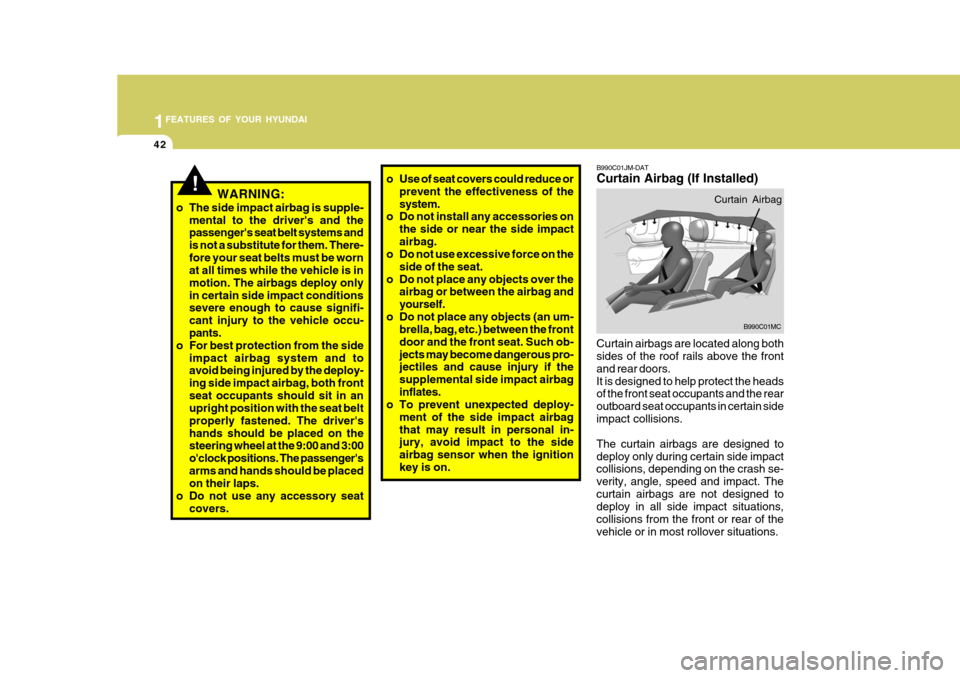
1FEATURES OF YOUR HYUNDAI
42
!o Use of seat covers could reduce or
prevent the effectiveness of the system.
o Do not install any accessories on
the side or near the side impactairbag.
o Do not use excessive force on the
side of the seat.
o Do not place any objects over the airbag or between the airbag andyourself.
o Do not place any objects (an um- brella, bag, etc.) between the frontdoor and the front seat. Such ob-jects may become dangerous pro- jectiles and cause injury if the supplemental side impact airbaginflates.
o To prevent unexpected deploy-
ment of the side impact airbagthat may result in personal in- jury, avoid impact to the side airbag sensor when the ignitionkey is on.
WARNING:
o The side impact airbag is supple- mental to the driver's and the passenger's seat belt systems and is not a substitute for them. There-fore your seat belts must be worn at all times while the vehicle is in motion. The airbags deploy onlyin certain side impact conditions severe enough to cause signifi- cant injury to the vehicle occu-pants.
o For best protection from the side
impact airbag system and to avoid being injured by the deploy- ing side impact airbag, both frontseat occupants should sit in an upright position with the seat belt properly fastened. The driver'shands should be placed on the steering wheel at the 9:00 and 3:00 o'clock positions. The passenger'sarms and hands should be placed on their laps.
o Do not use any accessory seat covers.
B990C01JM-DAT Curtain Airbag (If Installed)
Curtain airbags are located along both sides of the roof rails above the front and rear doors.It is designed to help protect the heads of the front seat occupants and the rear outboard seat occupants in certain sideimpact collisions. The curtain airbags are designed to deploy only during certain side impact collisions, depending on the crash se- verity, angle, speed and impact. Thecurtain airbags are not designed to deploy in all side impact situations, collisions from the front or rear of thevehicle or in most rollover situations. B990C01MC
Curtain Airbag
Page 55 of 232

1FEATURES OF YOUR HYUNDAI
44
o Modification to SRS components
or wiring, including the addition of any kind of badges to the pad covers or modifications to the body structure, can adversely affect SRSperformance and lead to possible injury.
o For cleaning the airbag pad cov- ers, use only a soft, dry cloth orone which has been moistened with plain water. Solvents or clean-ers could adversely affect the airbag covers and proper deploy- ment of the system.
o No objects should be placed over or near the airbag modules on thesteering wheel, instrument panel,and the front passenger's panel above the glove box, because any such object could cause harm ifthe vehicle is in a crash severe enough to cause the airbags to inflate.
o If the airbags inflate, they must be replaced by an authorised Hyundaidealer.
!
B240C01HP
WARNING:
o Extreme Hazard! Do not use a rear- ward facing child restraint on a seat protected by an airbag in front of it!
o Do not install a child restraint sys- tem in the front passenger seatposition. A child restraint system mustnever be placed in the front seat. The infant or baby could be se- verely injured by an airbag de-ployment in case of an accident.
B240C02NF-DAT SRS Care The SRS is virtually maintenance-free and so there are no parts you can safelyservice by yourself. If the SRS SRI (Service Reminder Indicator) does not come on, or continuously remains on,have your vehicle immediately in- spected by your authorised Hyundai dealer. Any work on the SRS system, such as removing, installing, repairing, or anywork on the steering wheel must be performed by a qualified Hyundai tech- nician. Improper handling of the SRSsystem may result in serious personal injury.
Page 73 of 232
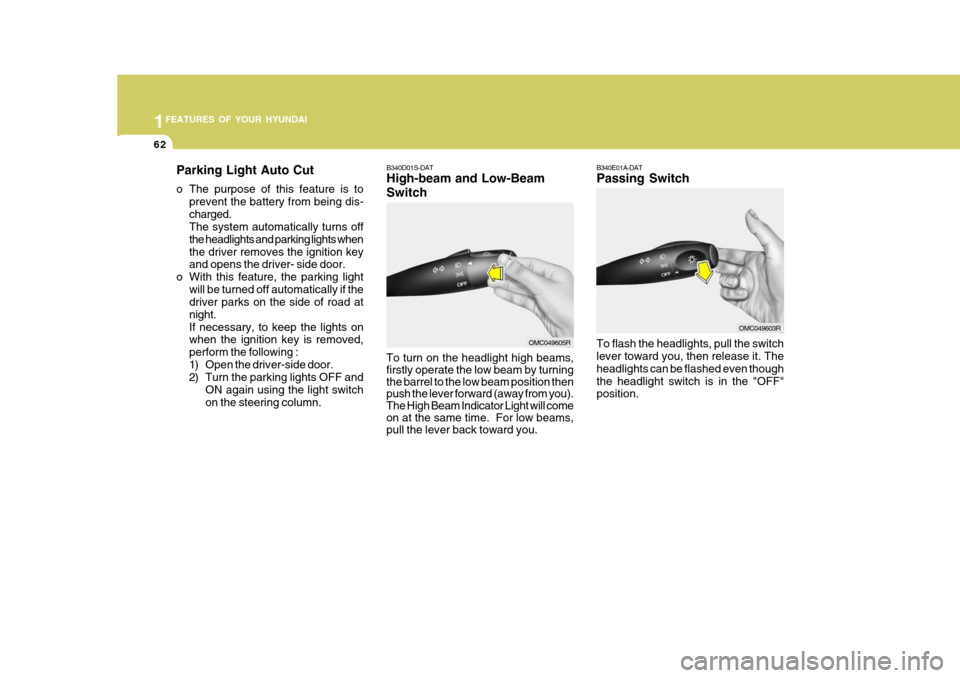
1FEATURES OF YOUR HYUNDAI
62
B340E01A-DAT Passing Switch To flash the headlights, pull the switch lever toward you, then release it. The headlights can be flashed even thoughthe headlight switch is in the "OFF" position.
B340D01S-DAT High-beam and Low-Beam Switch
OMC049605R
To turn on the headlight high beams, firstly operate the low beam by turning the barrel to the low beam position then push the lever forward (away from you). The High Beam Indicator Light will come on at the same time. For low beams, pull the lever back toward you.
OMC049603R
Parking Light Auto Cut
o The purpose of this feature is to
prevent the battery from being dis- charged. The system automatically turns off the headlights and parking lights whenthe driver removes the ignition key and opens the driver- side door.
o With this feature, the parking light will be turned off automatically if thedriver parks on the side of road at night.If necessary, to keep the lights on when the ignition key is removed, perform the following :
1) Open the driver-side door.
2) Turn the parking lights OFF and ON again using the light switch on the steering column.
Page 98 of 232
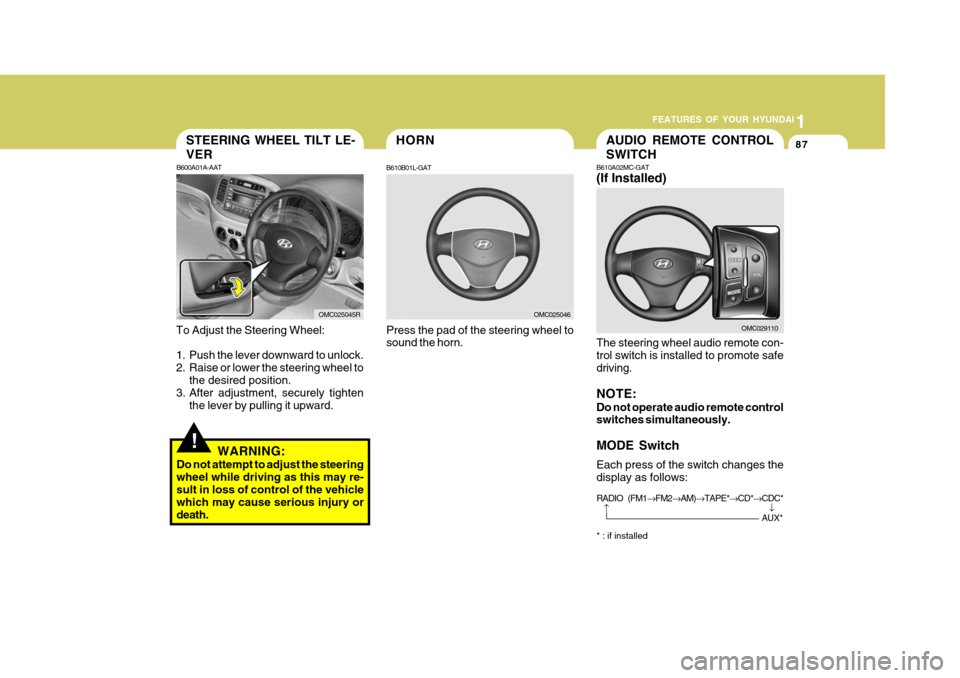
1
FEATURES OF YOUR HYUNDAI
87HORN
B610B01L-GAT
Press the pad of the steering wheel to sound the horn.
OMC025046
!
STEERING WHEEL TILT LE- VER
B600A01A-AAT
To Adjust the Steering Wheel:
1. Push the lever downward to unlock.
2. Raise or lower the steering wheel to the desired position.
3. After adjustment, securely tighten the lever by pulling it upward.
WARNING:
Do not attempt to adjust the steeringwheel while driving as this may re-sult in loss of control of the vehicle which may cause serious injury or death.
OMC025045R
AUDIO REMOTE CONTROL SWITCH
B610A02MC-GAT (If Installed) The steering wheel audio remote con- trol switch is installed to promote safe driving. NOTE: Do not operate audio remote control switches simultaneously. MODE Switch Each press of the switch changes the display as follows: * : if installed OMC029110
�
RADIO (FM1
�FM2 �AM) �TAPE* �CD* �CDC*�
AUX*
Page 131 of 232

2 DRIVING YOUR HYUNDAI
4
!
C040A01E
KEY POSITIONS
C070C01A-AAT
To Remove The Ignition Key
1. Turn the ignition key to the "ACC"position.
2. Simultaneously push and turn the ignition key counterclockwise from the "ACC" position to the "LOCK"position.
3. The key can be removed in the
"LOCK" position.
NOTE: Do not hold the key in the "START" position for more than 15 seconds.
o "ON" When the key is in the "ON" position, the ignition is on and all accessories may be turned on. If the engine is not running, the key should not be left inthe "ON" position. This will discharge the battery and may also damage the ignition system.
o "ACC" With the key in the "ACC" position, some electrical accessories (radio, etc.) may be operated.
o "LOCK" The key can be removed or inserted in this position.To protect against theft, the steering wheel locks by removing the key.
C040A02A-AAT
WARNING:
The engine should not be turned off or the key removed from the ignition key cylinder while the ve- hicle is in motion. The steeringwheel is locked by removing the key.
LOCK ACC
ON
START C070C01E
LOCK
ACC
ON
START
o "START" The engine is started in this position. It will crank until you release the key. NOTE: If difficulty is experienced turning the ignition key to the ACC position, turn the key while turning steeringwheel right and left to release the tension.
Page 135 of 232

2 DRIVING YOUR HYUNDAI
8
!
AUTOMATIC TRANSAXLE
NOTE:Depress the brake pedal and push the button when shifting. Push the button when shift- ing. The selector lever can be shifted freely.
For optimum fuel economy, acceler-ate gradually. The transaxle will auto- matically shift to the second, third andoverdrive gears.
C090A02A-GAT
The highly efficient Hyundai automatic transaxle has four forward speeds and one reverse speed. It has a conven-tional shift pattern as shown in the illustration. CAUTION:
Never shift into "R" or "P" position while the vehicle is moving.
accelerating or shifting gears. On aslippery surface, an abrupt change invehicle speed can cause the drive wheels to lose traction and the ve- hicle to go out of control.
WARNING:
o Avoid high cornering speeds.
o Do not make quick steering wheel movements, such as sharp lanechanges or fast, sharp turns.
o Always wear your seat belts. In a collision crash, an unbeltedperson is significantly more likelyto die than a person wearing a seat belt.
o The risk of rollover is greatly in- creased if you lose control ofyour vehicle at highway speeds.
o Loss of control often occurs if two or more wheels drop off theroadway and the driver oversteers to reenter the roadway.
o In the event your vehicle leaves the roadway, do not steer sharply.Instead, slow down before pullingback into the travel lanes.
o Never exceed posted speed limits.
OMC035014R
!